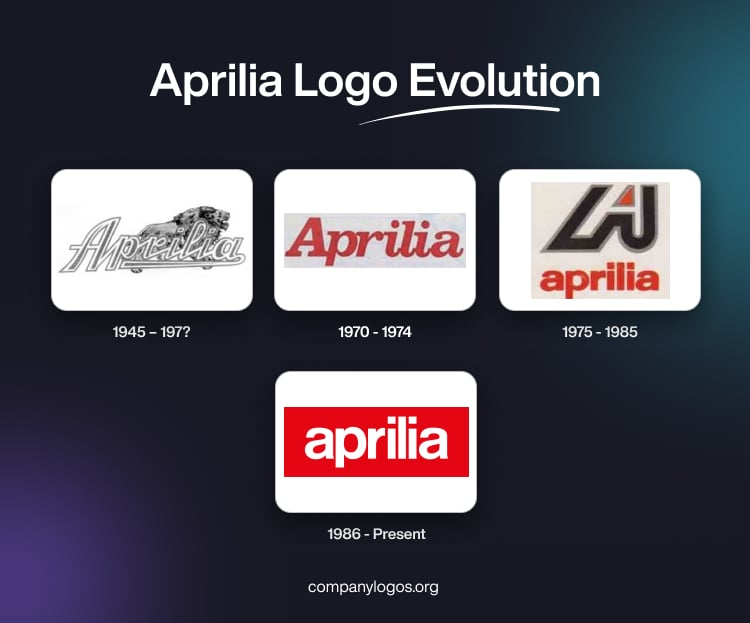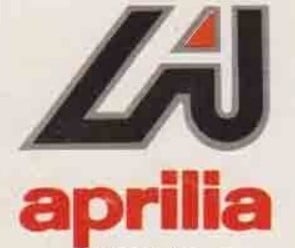
Aprilia is one of Italy’s most iconic motorcycle manufacturers that is renowned both for its high-performance machines and its strong brand identity. Established in 1945 by Cavalier Alberto Beggio and presently owned by Piaggio & Co. SpA., the company began by producing bicycles.
Central to this identity is its logo, which reflects the values of the company, namely, innovation, passion, and Italian craftsmanship. Over the decades, the Aprilia logo has evolved in step with its journey from a small bicycle manufacturer to a global leader in motorcycle racing and production. The article delves into the evolution of the Aprilia logo, among other details of the company.
The Genesis of the Aprilia Logo (1945 – 197?)
The original Aprilia logo comprised a charging lion emblem facing right and the brand name in the foreground. Designed in italics and in a stylish cursive typeface, the letters of the brand name had thin grey outlines with thick grey markings inside. Further, the end of the letter “a” was extended to the left.

(1970 – 1974)
The 1970 logo iteration featured the brand name with serifs in red. Rendered in italics and in a sans-serif typeface, the logotype was in a title case with the ends of the letters “i”, “l”, and “a” slightly protruding to the right.

(1975 – 1985)
In the 1975 logo iteration that lasted up to 1985, there was an italicised letter “A” in uppercase with thick grey outlines and a white interior. The letter was placed within a bigger black background with similar contours but with grey outlines. The small triangle formed by the letter was marked in red. Beneath the enlarged “A” was placed the brand name in red lowercase and rendered using a sans-serif typeface.

(1986 – Present)
The current logo features a bright red rectangular background with white “aprilia” text written in a traditional sans-serif typeface.The red colour conveys the progressive approach of the company, while the white lettering is about brand loyalty and reliability. The simple and minimalist logo is both eye-catching and memorable and evokes warm feelings.

The Elements of the Aprilia Logo
Font
The Aprilia logo consists of a single wordmark rendered in a traditional sans-serif typeface in lowercase. It is similar to Swiss 721 BdOul BT with clean lines. Besides, the letters “A” and “P” have bold curves and adequate spacing between the dots and the main body of the letter “I”.
Colour
The Aprilia logo uses a white (lettering) and red (background) colour palette.
The History of Aprilia
Aprilia was founded in 1945 by Cavaliere Alberto Beggio in the small Italian town of Noale, which is located in the Veneto region near Venice. Initially, the company focused on producing bicycles based on the immediate post-World War II demand and the original vision of the founder for the business.
The transformation from bicycles to motorcycles began in 1968 when Alberto Beggio’s son, Ivano Beggio, took over the family business. Ivano shifted the company’s focus to scooters and small-capacity motorcycles. The first Aprilia motorcycles were simple mopeds with 50 cc engines, and the early models included the Colibrì, Daniela, and Packi.
In 1970, Aprilia introduced the Scarabeo, which was a motocross bike produced in 50 cc and 125 cc variants. This marked Aprilia’s deeper commitment to motorcycle production and competition. The company quickly gained success in motocross racing by the mid-1970s. It won the Italian motocross championships in the 125 and 250 cc categories.
Through the 1980s, Aprilia expanded its range to include enduro, trials, and road motorcycles with displacements from 50 cc to 600 cc. Some of the notable models included the TL320 trials bike (1981), the ST125 road bike (1983), and the ET50 enduro (1984). Around 1985, Aprilia started sourcing engines from the Austrian manufacturer Rotax to boost performance and reliability while continuing to innovate in design and technology.
Aprilia entered into the international markets at the end of the 1980s, when the brand was imported to the United States and gained recognition beyond Italy. The company introduced liquid-cooled motorcycles like the TRX312M and The Climber, and the Pegaso 600 road bike with off-road heritage launched in 1990.
In the 1990s, Aprilia further established its reputation for sporty, high-performance motorcycles and urban mobility vehicles. It launched scooters such as the Amico and enhanced the iconic Scarabeo lineup. By 1998, Aprilia released the RSV Mille, which was a 1000 cc V-twin superbike that became synonymous with Italian motorcycle engineering excellence, as well as the Falco sport touring bike.
Starting in 2004, Aprilia became part of the Piaggio Group, Italy’s largest two-wheeled vehicle manufacturer. This acquisition gave Aprilia access to expanded resources and global distribution networks. It allowed the brand to maintain its racing heritage, innovation, and distinct identity in the motorcycle world.
Since its inception, Aprilia has grown from a modest post-war bicycle workshop to a highly respected global motorcycle brand that is famous for its racing success, technological innovation, and iconic Italian design. Its story remains deeply connected to the dedication and vision of the Beggio family.
Interesting Facts About Aprilia
- Aprilia was originally founded in 1945 by Cavaliere Alberto Beggio in Noale, Italy, as a bicycle manufacturing company. It wasn’t until the late 1960s that the company moved into producing mopeds and motorcycles under the leadership of his son, Ivano Beggio.
- Aprilia is one of the most successful brands in motorcycle racing history, with over 54 world championship titles, primarily in the MotoGP, 125cc, and 250cc categories. It is recognised as one of the most dominant brands in small-displacement racing.
- In its early years, Aprilia became famous for high-performance small-displacement motorcycles. Its RS and AF1 series set benchmarks in 125cc and 250cc racing machines for decades.
- Aprilia has been the stepping stone for some of the biggest names in motorcycle racing, including Valentino Rossi, Max Biaggi, and Jorge Lorenzo. All three started their world championship careers racing on Aprilia machines.
- The Scarabeo, which was introduced in the 1970s and revived in the 1990s as a scooter, is one of Aprilia’s most iconic models. It combined classic design with modern technology and became especially popular in Europe.
- Aprilia is renowned for equipping its sportbikes with cutting-edge electronics, which includes advanced traction control, wheelie control, launch control, and cornering ABS. These features, often seen in MotoGP, are also standard in its flagship models like the RSV4 and Tuono V4.
- In 2004, Aprilia became a part of the Piaggio Group, which also owns brands like Vespa, Moto Guzzi, and Derbi. This allowed Aprilia to expand its reach and benefit from shared technology and R&D.
- Aprilia was one of the first manufacturers to introduce a V4 engine in a production superbike with the launch of the RSV4 in 2009. The engine configuration provided a perfect balance of power, compactness, and performance.
- Unlike many competitors, Aprilia retains much of its design, engineering, and development in-house at its headquarters in Noale, Italy. This ensures a strong connection between its racing DNA and production models.
- Aprilia has been investing in electric mobility and urban mobility solutions, particularly with its e-scooters and lightweight electric motorcycles.
- The Tuono series, derived from its superbike counterpart RSV, is considered one of the most aggressive and performance-oriented naked bikes on the market. It blends comfort with track-level performance.
- Despite being a relatively smaller manufacturer compared to some Japanese giants, Aprilia has built a loyal global following, particularly among enthusiasts who value European design, exclusivity, and performance.
Finally
The Aprilia logo is a powerful symbol of a brand that has risen from humble beginnings to a dominant force in global motorcycling. The Aprilia logo represents Italian craftsmanship and racing success. Its evolution shows the company’s shift from local moped maker to internationally respected innovator and racing powerhouse.